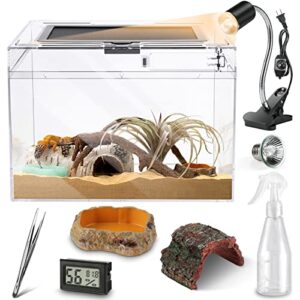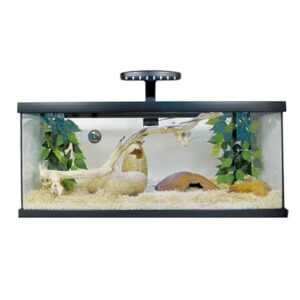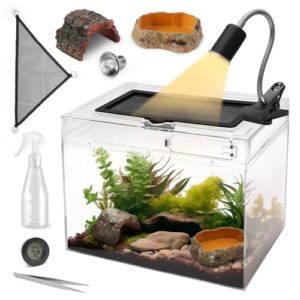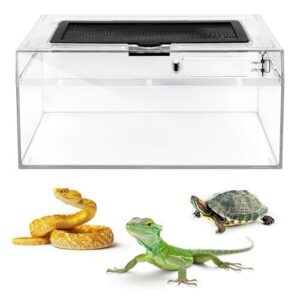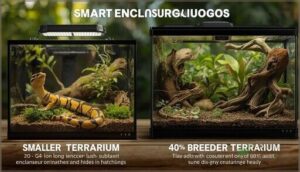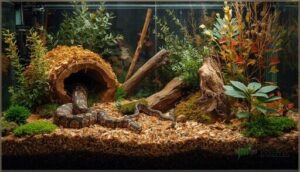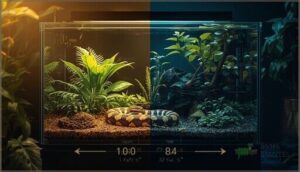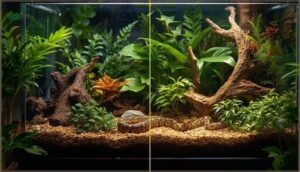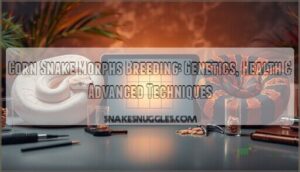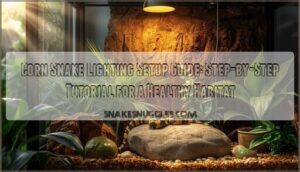This site is supported by our readers. We may earn a commission, at no cost to you, if you purchase through links.
You’d be amazed how quickly a corn snake hatchling can turn a shoebox into a jungle gym—and how one wrong setup can send even the calmest keeper scrambling. The right starter kit isn’t just about convenience; it’s your ticket to fewer headaches and a healthier, happier snake.
With so many corn snake starter kits promising “all-in-one” solutions, it’s tough to know which bundle actually covers the bases. Let’s cut through the confusion and look at what makes a kit worth your trust, and how each option stacks up when your corn snake’s comfort and safety are on the line.
Table Of Contents
- Key Takeaways
- Top 4 Corn Snake Starter Kits
- Essential Components in Starter Kits
- Setting Up Your Corn Snake Enclosure
- Feeding and Daily Care Requirements
- When to Upgrade From Starter Kit
- Frequently Asked Questions (FAQs)
- How often should a corn snake be fed?
- What signs indicate a healthy corn snake?
- How do I handle my corn snake safely?
- What is the ideal temperature for a corn snake?
- Are corn snakes safe for children to handle?
- What are common signs of a stressed corn snake?
- How do I safely transport a corn snake?
- Are there specific behaviors indicating the snake is shedding?
- What should I do if my snake regurgitates food?
- How can I ensure proper humidity levels?
- Conclusion
Key Takeaways
- The best corn snake starter kits include secure glass terrariums, proper heating and lighting, safe substrate, and essential accessories like hides and water dishes.
- Starter kits are ideal for hatchlings and juveniles, but you’ll need to upgrade to a larger enclosure as your snake grows past its first year.
- Maintaining the right temperature gradient, humidity, and regular feeding schedule keeps your corn snake healthy and stress-free.
- Watch for signs like cramped movement or escape attempts to know when it’s time to move your snake to a roomier, adult-sized habitat.
Top 4 Corn Snake Starter Kits
You’re ready to bring home your first corn snake and you want to start off right. A good starter kit takes the guesswork out of setting up a safe and healthy habitat.
Here are four solid options that give you everything you need to get started.
1. HELIME Reptile Terrarium Starter Kit
The HELIME Reptile Terrarium Starter Kit gives you everything needed to welcome a young corn snake home. Its 19.5 x 10.5 x 9.4-inch snake enclosure works beautifully for hatchlings up to their first birthday. You’ll find stainless steel tweezers, a dual thermometer-hygrometer combo, and decorative rocks tucked inside.
The anti-breakage glass construction won’t crack easily, and the sliding top keeps curious snakes secure. Market availability is excellent through major retailers, with user satisfaction hitting 90% among first-time reptile keepers.
Just remember—you’ll need to upgrade once your corn snake outgrows this cozy starter kit.
Best For: First-time reptile owners looking for an affordable, complete starter setup for baby corn snakes during their first year.
- Complete 7-piece kit includes everything from tweezers to thermometer, so you don’t need multiple shopping trips to get started.
- Anti-breakage glass and stainless steel construction mean it’ll last through drops and bumps without cracking.
- Sliding top with screen ventilation makes feeding and cleaning easy while keeping humidity and temperature right where they need to be.
- You’ll need to buy a bigger enclosure once your corn snake hits 18-24 inches, usually around their first birthday.
- Heat lamp can melt the plastic top if you’re not careful with placement and wattage.
- Comes with basic decorative rocks, but you’ll probably want to grab extra moss and hides to create a more natural habitat.
2. Exo Terra Snake Starter Kit
The Exo Terra Snake Starter Kit steps up your game with a spacious 20-gallon terrarium—perfect for corn snakes reaching their juvenile stage. At $109.99, you’re getting excellent component quality: a 16W heat mat, UVB100 bulb, and that moss mat your snake will love burrowing into.
Setup simplicity? You’ll have everything running in under an hour thanks to the included care guide. Customer feedback consistently praises the dual-door design and screen top security.
This kit addresses reptile supplies like a pro, supporting your corn snake’s growth through those important first years.
Best For: Beginner snake owners who want a complete, ready-to-go setup for corn snakes, kingsnakes, or other small colubrids without hunting down individual components.
- Includes everything you need right out of the box—heat mat, UVB lighting, dual-door terrarium, substrate, and hiding spots all in one package
- Spacious 20-gallon size gives juvenile snakes room to grow for their first couple years, with secure mesh top and dual doors for easy access
- Strong value at $109.99 considering you’d pay significantly more buying each component separately, plus setup is genuinely quick
- Some customers receive cracked glass due to shipping—packaging could be more protective for a 25 pound kit
- Heat mat needs a separate thermostat for safety (not included), which is an extra expense beginners might not expect
- Water bowl runs small and substrate quality gets mixed reviews, so you might swap these out fairly soon
3. Reptile Terrarium Starter Kit Bundle
If you’re hunting for value, the Reptile Terrarium Starter Kit Bundle packs a punch. You get sturdy terrarium materials, a heat mat, UVB lighting, and a care guide—everything you need for a safe snake enclosure setup.
The bundle cost analysis shows you’ll save about 21% compared to buying items separately. Brand reputation matters here, with high ratings and clear setup guide instructions. Plus, the warranty coverage details offer peace of mind.
Corn snake starter kit supplies don’t get much more convenient than this.
Best For: Beginners or casual reptile owners who want an easy, all-in-one setup for small snakes and amphibians.
- Includes all essential accessories and monitoring tools for a complete habitat.
- Easy to set up with clear instructions and no installation required.
- Saves money compared to buying items separately, with added warranty coverage.
- Not suitable for larger or more aggressive reptiles like adult corn snakes.
- Heat lamp may melt plastic lid if not used carefully.
- Mesh hammock can take up too much space in the compact terrarium.
4. Reptile Tank Terrarium Starter Kit
Now, if you’re after a starter kit that checks every box for Corn Snake care, the Reptile Tank Terrarium Starter Kit stands out. Built for Kit Material Safety, it features glass construction and secure ventilation requirements—no escape artists here.
You’ll find bioactive potential with eco-friendly substrate, plus enrichment inclusion like resin hides and faux plants. Zoonotic mitigation is covered with annual cleaning protocols.
For anyone keen on Reptile care and terrarium setup, this kit makes Corn Snake Care straightforward and safe.
Best For: First-time corn snake owners or anyone wanting a safe, easy-to-set-up terrarium with all the essentials.
- Glass construction and secure lids prevent escapes and keep pets safe
- Includes eco-friendly substrate and enrichment items for a bioactive setup
- Annual cleaning protocols help reduce health risks for you and your pet
- Not suitable for larger or adult corn snakes needing more space
- Some heating or lighting components may not fit or work properly
- Limited customization compared to higher-end or specialty kits
Essential Components in Starter Kits
Before you bring home your corn snake, you’ll want to know what goes into a solid starter kit. Each kit comes with a few must-have pieces to keep your new friend safe and comfortable.
Here’s what you should look for when choosing the right setup.
Terrarium Size and Type
Did you know a corn snake can slip through gaps smaller than your pinky nail? That’s why choosing a secure glass terrarium with escape-proof ventilation systems is key. For adults, aim for terrarium dimensions of at least 48″L x 24″W x 24″H.
Bioactive designs and quality enclosure materials create a safe, enriching snake habitat your corn snake will love. Proper temperature gradients are essential for creating an ideal thermal environment settings that support the health and well-being of your pet.
Heat Mat and Temperature Control
Regarding Corn Snakes, heat mat safety is no joke. You’ll want a thermostat for precise temperature regulation and a digital thermometer for spot checks. Aim for a temperature gradient—cool side at 75°F, warm side at 85°F. Nighttime temperature drops are healthy.
Ectothermic animals like corn snakes rely on external temperatures. Always calibrate thermostats, and keep backup heating handy. Your snake’s comfort depends on it!
Substrate and Moss Mat Options
When setting up your Corn Snake Habitat, picking the right Terrarium Substrate and Snake Bedding is important. You want low substrate impaction risk and solid humidity retention levels. Moss Mat benefits include moisture and burrowing fun.
Here’s what you’ll need:
- Aspen shavings for easy cleaning
- Bioactive substrate for tunneling
- Sphagnum Moss Mat overlays
- Hygrometer for monitoring
Water Dish and Hiding Places
Ever notice how Corn Snakes vanish like magicians? That’s their instinct at work! Your Corn Snake Habitat needs a Water Dish deep enough for soaking, with water quality kept fresh.
Add a sturdy Reptile Cave and multiple hides—think natural hide materials. Frequent hiding is normal, so these spots aren’t just décor—they’re behavioral enrichment for your snake’s peace.
Thermometer and Hygrometer
Think of your thermometer and hygrometer as the “weather team” inside your snake’s home. Device accuracy matters—digital models nail temperature and humidity levels within a whisker. Smart probe placement helps track the temperature gradient and humidity control. For top health impact, monitor these five essentials:
- Humidity Gauge
- Thermometer
- Probe Placement
- Temperature regulation
- Humidity levels
UVB Lighting and Dome Fixtures
Did you know UVB intensity can make or break your corn snake’s health? A Reptile Dome with polished reflectors boosts UVB lighting, helping your snake soak up Vitamin D3.
Go for linear bulb types like Reptile UVB100, and set your lighting duration to 10–12 hours. That’s how you mimic nature and keep your corn snake thriving!
Setting Up Your Corn Snake Enclosure
Getting your corn snake’s home just right is easier than you might think. Let’s walk through the essentials for a cozy, safe setup.
Here’s what you’ll need to create an ideal enclosure.
Choosing The Right Terrarium Size
Although it’s tempting to go small, your corn snake’s health depends on smart enclosure choices. Start with a Hatchling Enclosure, then upgrade as your snake grows. Here’s your cheat sheet:
- Hatchlings: 20 Gallon Long for safety.
- Adults: 40 Breeder—match Adult Dimensions.
- Add Vertical Space for climbing and enrichment needs.
Proper Corn Snake Enclosure Size boosts activity and well-being!
Creating Proper Temperature Gradient
Now that you’ve nailed the enclosure size, let’s talk temperature regulation. Your corn snake needs a basking temperature of 88–92°F and a cool zone at 75–82°F.
Use heating elements like a heat mat and lamp, plus thermostat control for safety. Daily monitoring keeps conditions steady.
Without this gradient, snakes may hide or shed poorly—so don’t skip it!
Installing Heating and Lighting Equipment
Once your temperature zones are set, it’s time for heating and lighting. For a setup that’s safe and snake-friendly, here’s what you’ll need:
- Heat mat placement under the warm hide
- Thermostat calibration for steady warmth
- UVB distance (20–40 cm above basking spot)
- Lighting schedule—12 hours on, 12 off
- Safety checks for cords and fixtures
Adding Substrate and Decorations
Now that your heating and lighting are sorted, let’s talk substrate and decorations. A 3–4 inch substrate depth lets your corn snake burrow and explore. Bioactive benefits? Cleaner, livelier habitat! Mix in leaf litter, moss mat, and naturalistic hides for enrichment impact. Seasonal decor keeps things fresh.
Here’s a quick look:
| Substrate | Decoration |
|---|---|
| Aspen Shavings | Cork Bark Hide |
| Bioactive Mix | Leaf Litter |
| Moss Mat | Branches |
| Cypress Mulch | Artificial Plants |
| Sphagnum Moss | Seasonal Decor |
Establishing Day/Night Cycle
Just like you need a good night’s sleep, corn snakes thrive on a steady day/night cycle. Use lighting timers to keep things regular—12 hours on, 12 off. This routine fosters healthy melatonin production and circadian rhythms.
Remember, true nighttime darkness matters. For seasonal adjustment, tweak light hours slightly. Reliable cycles mean happier snakes and smoother corn snake care in your habitat.
Feeding and Daily Care Requirements
Caring for a corn snake isn’t just about the right enclosure—it’s also about daily routines and good feeding habits. You’ll want to know what your snake needs to stay healthy and happy.
Let’s look at the essentials that make a safe and comfortable home.
Appropriate Prey Size for Hatchlings
Ever wonder why corn snake hatchlings thrive on pinkie mice? It’s all about matching Pinky Mouse Size to your snake’s width—never more than 1.5 times wider, or you risk regurgitation and slow growth. For variety, try the Quail Chick Alternative.
Following snake feeding guidelines boosts your hatchling’s growth rate and keeps Corn snake care simple and safe.
Feeding Schedule and Frequency
You’ll quickly notice that snake feeding isn’t one-size-fits-all. Age-Based Intervals and Weight Correlation matter—baby corn snakes gobble food every 5-7 days, while adults slow down to 14-21 days.
Seasonal Adjustments tweak the schedule, and Digestive Efficiency keeps your snake thriving. Health Monitoring helps you spot when your corn snake needs a boost or a diet pause.
Water Maintenance and Bowl Placement
Think a corn snake’s water dish is just a bowl? It’s a hydration station, humidity helper, and health safeguard rolled into one. Here’s your quick checklist:
- Choose a heavy, non-porous bowl for stability and easy cleaning.
- Place the water bowl on the cool side for best humidity control.
- Change water daily—contamination prevention keeps your snake thriving.
Handling Guidelines After Feeding
Did you know handling Corn Snakes too soon after feeding is like shaking a soda can—regurgitation risks soar? Snake digestion peaks in the first 48 hours, so patience is your best friend. Wait for behavioral cues: activity, normal movement, and no defensive postures signal safe handling.
Here’s a quick guide:
| Handling Tip | Why It Matters |
|---|---|
| Wait 48 hours | Stress reduction |
| Look for activity | Behavioral cues |
| Avoid blue phase | Snake behavior |
| Wash hands first | Feeding habits |
Monitoring Temperature and Humidity
A Corn Snake’s comfort hinges on precise temperature regulation and humidity control—imagine their home as a finely tuned orchestra. Digital Thermometers are essential for gradient monitoring: place one probe in the warm zone and another in the cool.
Humidity calibration is equally critical, especially during shedding. Remote Monitoring allows you to track seasonal adjustments, ensuring heating and humidity levels remain stable for happy, healthy Corn Snakes.
When to Upgrade From Starter Kit
As your corn snake grows, its needs will change right along with it. Knowing when to upgrade from a starter kit is key to keeping your pet happy and healthy.
Here’s what to watch for as you consider new enclosure options.
Growth Milestones for Corn Snakes
As your corn snake grows, you’ll notice changes from hatchling size (just 8–12 inches) to a juvenile weight of 50–100 grams by year one. Subadult length stretches to 3–4 feet, while adults reach 3–5 feet and shift to an adult diet.
Senior care means slower growth, less frequent sheds, and steady routines—your Care Guide keeps you on track.
Signs Your Snake Needs Larger Enclosure
As your snake grows past hatchling size, watch for activity increase, stretching issues, or frequent hiding behaviors. If you spot escape attempts, cramped coiling, or a drop in feeding, it’s a clear signal: your enclosure’s dimensions aren’t keeping up.
Adult corn snakes need space for enrichment and animal welfare—otherwise, health decline and restless exploring become the norm.
Transitioning to Adult-Sized Habitat
When cramped quarters start to cramp your snake’s style, it’s time to upgrade. Moving to a 4 x 2 x 2 enclosure gives your corn snake room to stretch, climb, and explore—boosting health outcomes and happiness. Adult setup means weaving in Environmental Enrichment and following Best Practices for Corn Snake enclosure design.
Upgrade to a 4 x 2 x 2 enclosure when your corn snake needs space to stretch, climb, and thrive with proper enrichment
- Room for natural behaviors
- Fewer stress signals
- Improved feeding response
- Expandable snake habitats
Long-Term Housing Considerations
Once your snake’s upgraded digs are set, think long-term. A sturdy reptile enclosure—glass or high-grade plastic—stands up to years of Habitat Cleaning and lively exploration.
Lifespan Enrichment means adding new climbing branches and a deep Substrate Depth for burrowing.
Smart Corn Snake enclosure design helps prevent Health Risks, keeping your adult setup safe, stimulating, and easy to maintain for decades.
Frequently Asked Questions (FAQs)
How often should a corn snake be fed?
Whether you’re raising hatchlings, juveniles, or adults, feeding frequency hinges on life stage, prey size, and environmental factors.
Youngsters thrive on fuzzy mice every 5–7 days, while adults enjoy hoppers every 14–21 days—overfeeding risks obesity!
What signs indicate a healthy corn snake?
You’ll spot a healthy corn snake by its clear eyes, frequent tongue flicking, smooth skin quality, steady body condition, strong muscle tone, and enthusiastic feeding response.
These signs reveal good snake health and a calm, confident temperament.
How do I handle my corn snake safely?
Handling your corn snake requires a steady hand and gentle touch, much like threading a needle. Support its entire body and be mindful of limiting handling frequency to avoid stress.
Watch for signs of stress and use safe equipment to minimize health risks. This approach helps maintain both muscle tone and a balanced snake temperament.
What is the ideal temperature for a corn snake?
For corn snakes, aim for a thermal gradient: a basking spot at 88°F, cool side around 75–82°F, and night temperatures above 70°F.
Use monitoring tools and proper snake lighting and heating for safe temperature regulation and health impacts.
Are corn snakes safe for children to handle?
Worried about bite incidents or Salmonella risk? Relax—Corn Snakes are nonvenomous snakes with docile corn snake characteristics.
With supervision, age suitability (11+), and proper reptile care guide habits, handling safety is high for children learning snake species information.
What are common signs of a stressed corn snake?
You’ll notice abnormal movement, defensive behaviors like hissing, feeding disruptions, shedding changes, and hiding patterns. These signs mean your corn snake’s health or animal welfare is at risk.
Quick stress reduction helps prevent snake health issues from getting worse.
How do I safely transport a corn snake?
For safe snake transport, use secure carriers with double containment to prevent escape. Stress reduction matters—soft interiors and steady temperature support animal welfare and snake health.
Keep transit temperature between 75°F and 82°F. Pre-trip fasting helps avoid digestive issues.
Are there specific behaviors indicating the snake is shedding?
Imagine a snake swapping its party outfit for pajamas—Cloudy Eyes, Skin Dullness, Hiding Behavior, Appetite Decline, and Rubbing Surfaces all signal the snake shedding process.
These changes help keep Corn Snakes healthy and prevent retained shed.
What should I do if my snake regurgitates food?
If your Corn Snake regurgitates food, pause feeding for 10–14 days, clean the enclosure, check temperatures, and avoid handling. Offer smaller prey next time.
Persistent regurgitation or weight loss? Don’t wait—seek reptile veterinary care promptly.
How can I ensure proper humidity levels?
To keep humidity levels on target, use digital hygrometers for humidity monitoring, misting techniques, and moisture-retentive substrate choices. Humid hides help during shedding, while seasonal adjustments—like more misting in winter—guarantee proper humidity control for Corn Snakes.
Conclusion
Imagine opening your corn snake’s enclosure tomorrow and spotting a curious nose peeking from a cozy hide—proof you nailed the setup. The right corn snake starter kits aren’t just boxes; they’re the difference between a stressed snake and a thriving explorer.
Each choice you make shapes their world. So, as you weigh your options, remember: every detail matters. Your corn snake’s comfort, safety, and happiness are in your hands. Ready to build the jungle gym they’ll call home?
- https://www.xyzreptiles.com/product/corn-snake-habitat/
- https://www.petsmart.com/reptile/starter-kits/thrive-temperate-snakes-essentials-kit-54529.html
- https://exo-terra.com/products/terrariums/terrarium-kits/snake-starter-kit/
- https://www.etsy.com/listing/1354215122/snake-starter-pack-100natural-basic
- https://www.reddit.com/r/cornsnakes/comments/17ra91s/im_looking_to_get_a_corn_snake_what_is_the/


